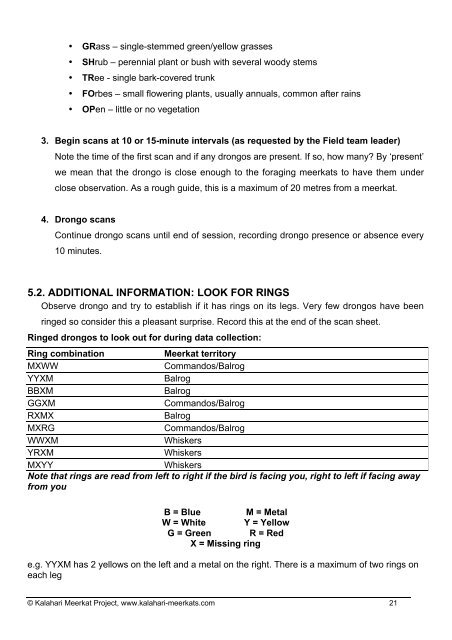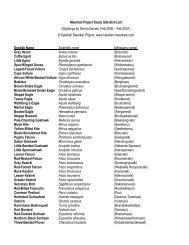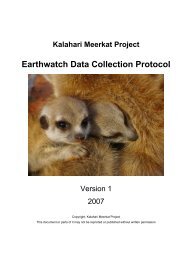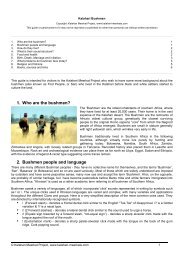Earthwatch Field Guide - The Kalahari Meerkat Project
Earthwatch Field Guide - The Kalahari Meerkat Project
Earthwatch Field Guide - The Kalahari Meerkat Project
Create successful ePaper yourself
Turn your PDF publications into a flip-book with our unique Google optimized e-Paper software.
• GRass – single-stemmed green/yellow grasses• SHrub – perennial plant or bush with several woody stems• TRee - single bark-covered trunk• FOrbes – small flowering plants, usually annuals, common after rains• OPen – little or no vegetation3. Begin scans at 10 or 15-minute intervals (as requested by the <strong>Field</strong> team leader)Note the time of the first scan and if any drongos are present. If so, how many? By ‘present’we mean that the drongo is close enough to the foraging meerkats to have them underclose observation. As a rough guide, this is a maximum of 20 metres from a meerkat.4. Drongo scansContinue drongo scans until end of session, recording drongo presence or absence every10 minutes.5.2. ADDITIONAL INFORMATION: LOOK FOR RINGSObserve drongo and try to establish if it has rings on its legs. Very few drongos have beenringed so consider this a pleasant surprise. Record this at the end of the scan sheet.Ringed drongos to look out for during data collection:Ring combination<strong>Meerkat</strong> territoryMXWWCommandos/BalrogYYXMBalrogBBXMBalrogGGXMCommandos/BalrogRXMXBalrogMXRGCommandos/BalrogWWXMWhiskersYRXMWhiskersMXYYWhiskersNote that rings are read from left to right if the bird is facing you, right to left if facing awayfrom youB = Blue M = MetalW = White Y = YellowG = Green R = RedX = Missing ringe.g. YYXM has 2 yellows on the left and a metal on the right. <strong>The</strong>re is a maximum of two rings oneach leg© <strong>Kalahari</strong> <strong>Meerkat</strong> <strong>Project</strong>, www.kalahari-meerkats.com 21





